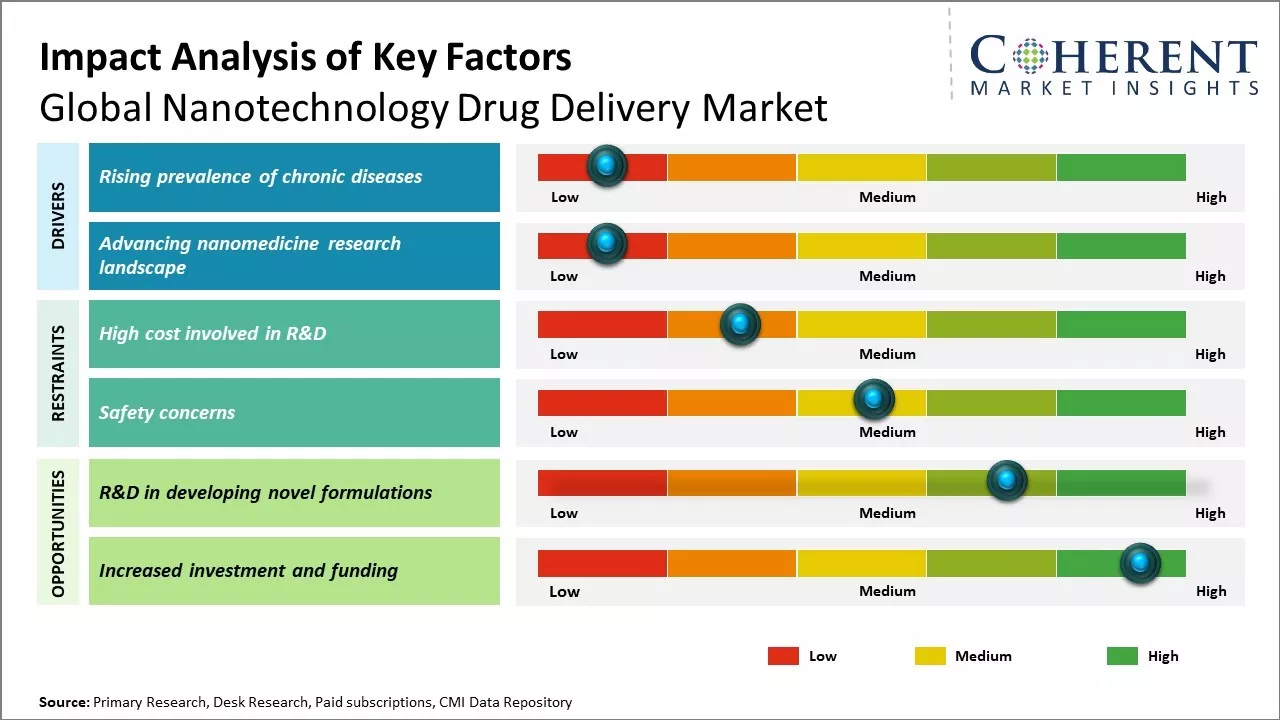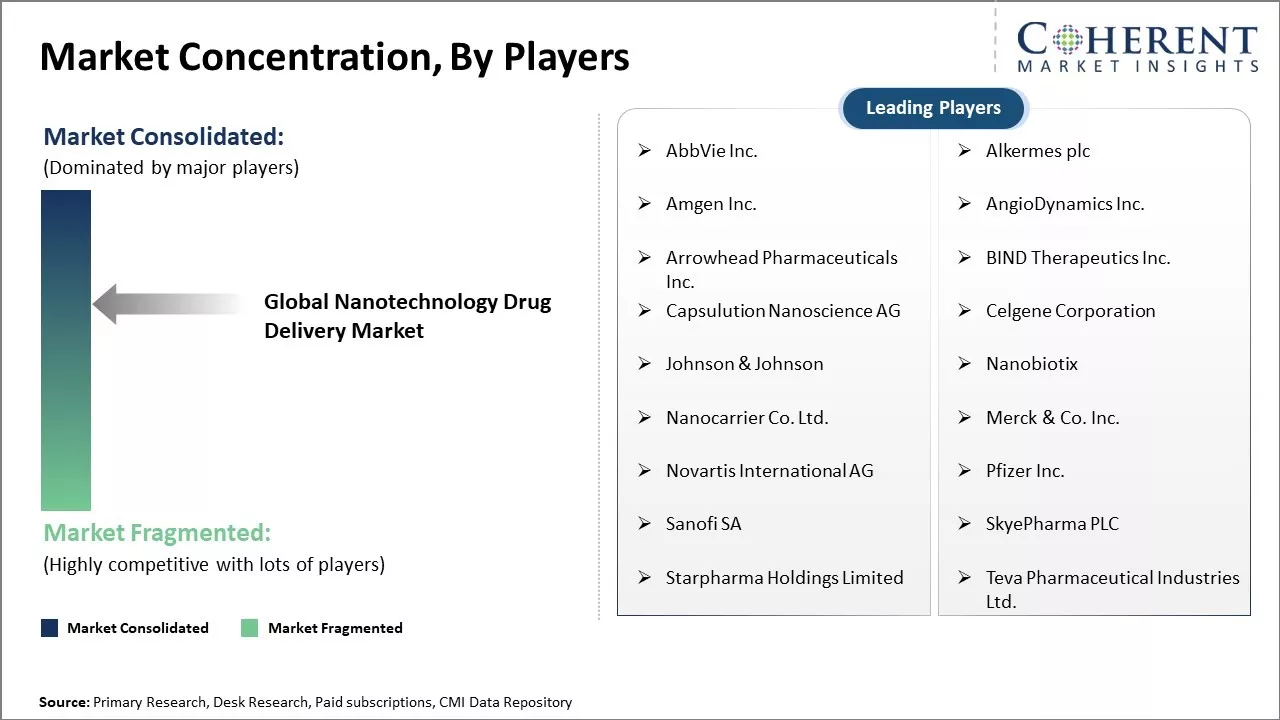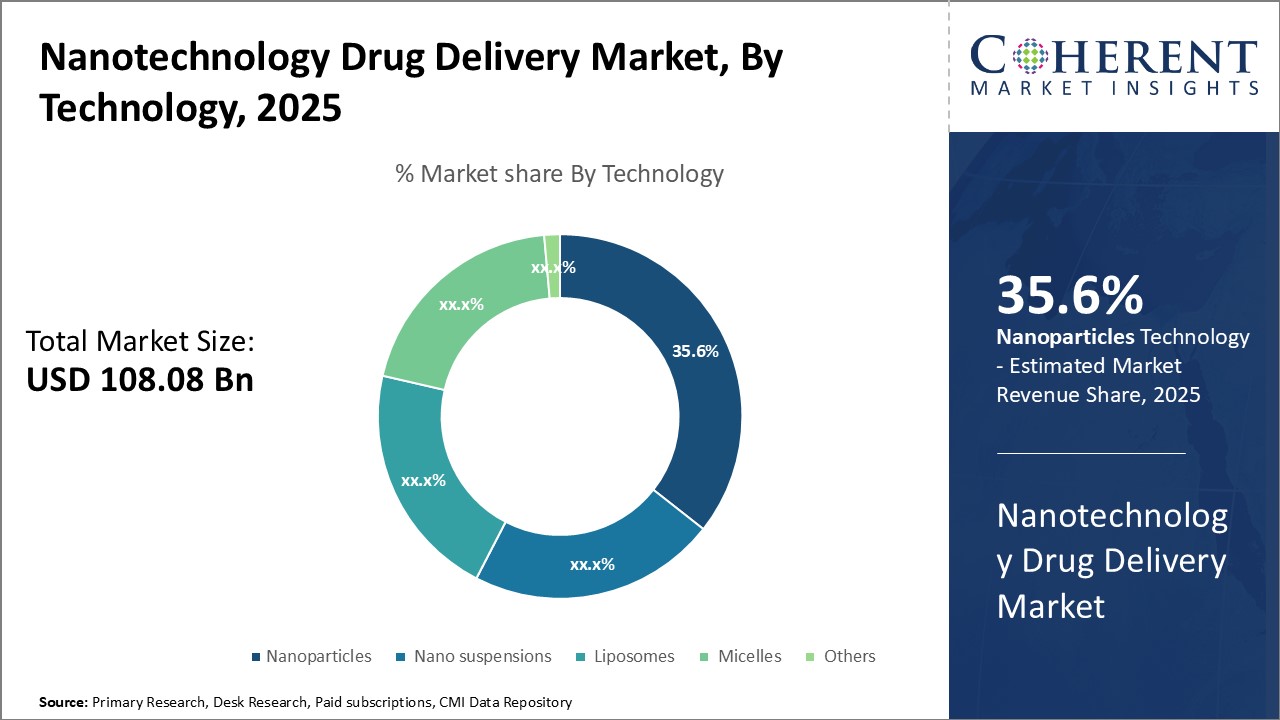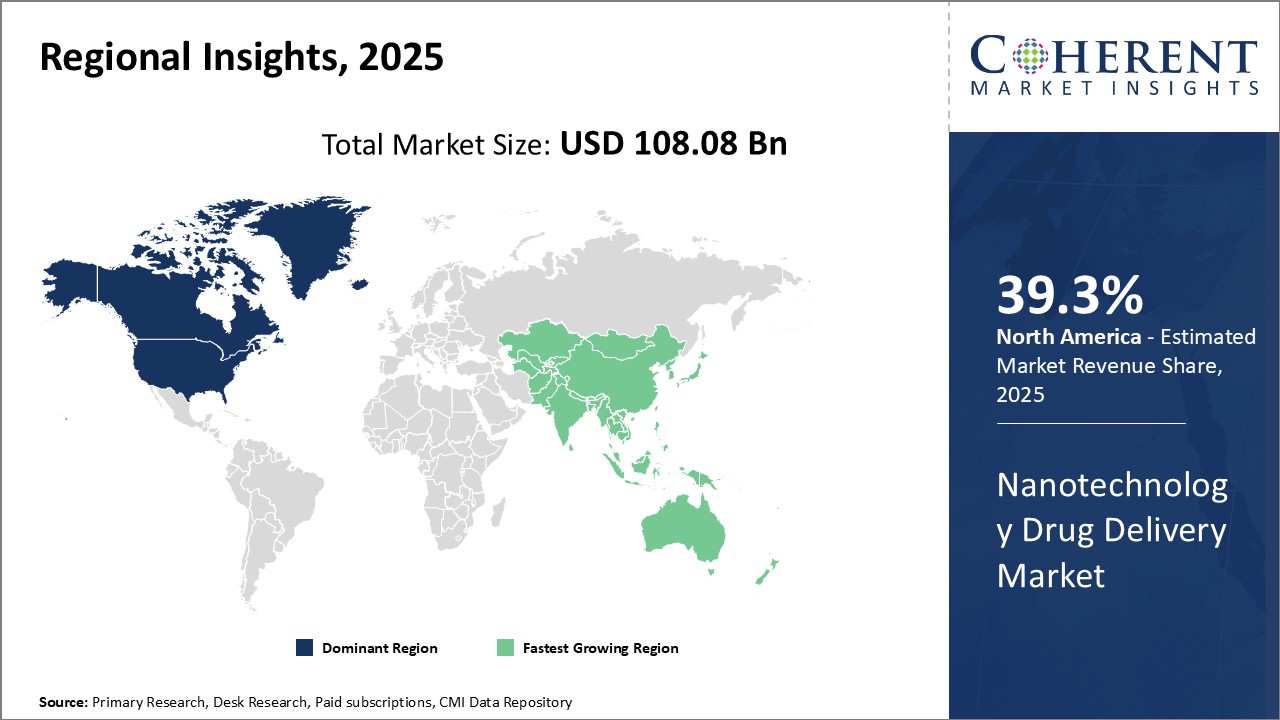Global nanotechnology drug delivery market is estimated to be valued at USD 108.08 Bn in 2025 and is expected to reach USD 228.82 Bn by 2032, exhibiting a compound annual growth rate (CAGR) of 11.3% from 2025 to 2032. Nanotechnology drug delivery utilizes nanomaterials and nanodevices to transport therapeutic agents in the body. Increased precision and effectiveness of these systems over conventional drug delivery methods can drive the market growth.

Discover market dynamics shaping the industry: Request sample copy
The market is expected to witness significant growth over the forecast period due to rising adoption of nanotechnology drug delivery for various disease indications. Active research on utilizing nanocarriers for delivery of different types of drug molecules such as proteins, genes and chemotherapeutic agents can also drive the market growth. Furthermore, continuous pipeline development of nanomedicines and their commercialization can boost demand.
Rising prevalence of chronic diseases
Increasing prevalence of chronic diseases such as cancer, cardiovascular diseases, diabetes and other lifestyle diseases can boost demand for more effective drug delivery systems. According to the World Health Organization, chronic diseases accounted for approximately 60% of all deaths globally in 2020. Developing regions have been particularly impacted due to risk factors like increasing pollution levels, growing adoption of sedentary lifestyles and aging populations. Many traditional drug delivery methods suffer from low bioavailability, short half-life and systemic toxicity issues. Nanotechnology approaches can overcome these challenges by enabling targeted delivery and controlled release of drugs inside the body. For example, nano-carriers can be designed to encapsulate antineoplastic drugs and transport them specifically to tumor sites, thus, reducing side effects and improving treatment outcomes. Such patient-centric product development focusing on minimizing disease burden as well as healthcare costs appeals to both patients and providers alike. For instance, in December 2023, according to the United Health Foundation’s America’s Health Rankings 2023 Annual Report, the prevalence of eight chronic health conditions in the U.S. has reached unprecedented levels. These conditions, including arthritis, asthma, cancer, cardiovascular diseases (CVDs), chronic kidney disease, chronic obstructive pulmonary disease (COPD), depression, and diabetes, have reached their highest recorded levels since tracking began in 1990.

Get actionable strategies to beat competition: Request sample copy
Advancing nanomedicine research landscape
Rising investments from public and private entities into nanomedicine research over the past decade have expanded the scientific knowledge base and accelerated technology maturation. Global initiatives like the National Nanotechnology Initiative in the U.S. have galvanized cross-disciplinary R&D collaborations between engineers, biologists and clinicians. Advancements in characterization tools now allow more comprehensive understanding of nano-bio interactions at the molecular level. Computation capabilities are helping to design nano constructs via virtual modeling and simulate their performance under different physical conditions. Such learnings can be applied to optimize lead candidates and shorten development cycles. COVID-19 has further amplified focus on self-amplifying mRNA technologies for systemic nucleic acid delivery with vaccines. Continued government funding for exploratory projects and renewed interest from pharma/biotech firms in nanotherapeutics commercialization bode well for wider translation of nanotechnology innovations into clinically useful drug delivery platforms.
Key Takeaways from Analyst:
Global nanotechnology drug delivery market can witness growth over the next decade. The ability of nanomedicine to deliver drugs in a more targeted manner and improve bioavailability is increasingly being recognized by pharmaceutical companies. This boosts further research and development into nanoparticle-based therapies. Increased funding from governments and private investors into nanomedicine research can offer opportunity for new innovation in drug delivery systems.
Asia Pacific will emerge as the fastest growing region due to rising healthcare investments, increasing focus on R&D activities, and a large patient pool. Countries like China and India offer strong manufacturing capabilities and may become major outsourcing destinations for drug delivery research. High set up and instrumentation costs associated with nanotechnology can pose a challenge, especially for small startup ventures.
Regulatory hurdles and lengthy approval times can hamper the market growth. As nanomedicines often behave differently than conventional drugs, new guidelines need to be formulated to ensure patient safety. Lack of standardized characterization procedures and unclear regulatory pathways can delay clinical trials. Successfully navigating regulatory complexities is important for companies to bring novel formulations to market.
Market Challenges: High cost involved in R&D
High costs associated with research and development activities can hamper the global nanotechnology drug delivery market growth. Developing nanomedicines and targeted drug delivery systems requires extensive research and testing over several years. It involves investigating the interaction of nanoparticles with biological systems at a molecular level and evaluating their pharmacokinetics, biocompatibility, and toxicity aspects thoroughly before these can be tested on humans. This entire process from molecule design to clinical trials is an expensive and resource-intensive endeavor. For instance, according to the data published by Global Burden of Disease Cancer Collaboration in 2020, the median worldwide research expenditure for designing one new cancer drug was estimated to be US$ 648 million. This included expenditures on drug discovery, preclinical and clinical development, as well as post-marketing studies. Out of this, costs for phase 3 clinical trials alone amounted to nearly US$ 200 million per new cancer drug. Due to high R&D costs, developing safe and efficacious nano-based formulations within budget constraints can pose significant challenges for pharmaceutical companies and research institutes. The high failure rate of drug candidates during clinical evaluation also adds to the financial risks associated with nanomedicine research.
Market Opportunities: R&D in developing novel formulations
The evolving area of nanotechnology can offer opportunities for drug delivery applications globally. Developing novel formulations at the nanoscale that can effectively target site-specific delivery significantly impact patients' lives and drive the market growth. By engineering nanoparticles, liposomes, dendrimers and other nanocarriers, researchers are working towards increasing bioavailability, solubility and stability of drug molecules. This allows for targeted distribution of drugs in the body, with minimal side-effects. For instance, researchers at the National Cancer Institute developed a nanocarrier that can deliver 50 times the amount of chemotherapy drugs directly to the brain tumors as compared to traditional treatment methods. This has the potential to improve outcomes for patients with difficult to treat cancers. Continued R&D in cell-specific targeting technologies could enable precision delivery of therapeutic payloads like genes, proteins and antibodies to treat a wide range of diseases. Novel nanosystems that can track biological cues in the body and release drug molecules accordingly would revolutionize ways to diagnose and treat cancer, cardiovascular diseases, neurological disorders, and more.

Discover high revenue pocket segments and roadmap to it: Request sample copy
Insights, By Technology - Precision targeting boosts nanoparticles segment growth
In terms of technology, nanoparticles segment is estimated to contribute the highest market share of 35.6% in 2025, owing to their precise targeting capabilities. Nanoparticles have nanoscale dimensions that allows them to penetrate deep into tissues and accurately deliver drugs. Their small size means that these can easily enter cells and release therapeutic agents with pinpoint targeting. This precise targeting ability helps to improve the efficacy of many cancer and infectious disease treatments. Nanoparticles are extensively researched to develop advanced drug delivery systems that can cross biological barriers like the blood brain barrier. Many clinical trials are underway to develop nanoparticle-based drugs that can treat brain cancers and neurological disorders more effectively. The large research focus on nanoparticles is expanding the technology's applications and driving more product approvals and commercialization. The inherent targeting properties of nanoparticles make them highly suitable for many disease treatments, thus, driving the segment growth.
Insights, By Application - High disease burden boosts oncology and hematology segment dominance
In terms of application, oncology and hematology segment is estimated to contribute the highest market share of 30.51% in 2025, due to the rising prevalence of cancer. . Cancer is one of the leading causes of death worldwide with millions of new cases diagnosed each year, thus, this boosts demand for advanced treatment options. Nanotechnology drug delivery systems offer promising solutions by enabling more targeted and less toxic cancer therapies. Nanocarriers can be designed to preferentially accumulate in tumor tissues via the enhanced permeability and retention effect. This allows anti-cancer drugs to be delivered precisely to the site of the tumor while avoiding healthy tissues and lowering systemic side effects. Many nanomedicine products in clinical trials shows improved efficacy against cancers like lung cancer, breast cancer and blood cancers. The vast unmet medical need for new cancer treatments boosts investment and research into nanotechnology solutions.
Insights, By End User - Hospitals drive hospitals & clinics segment leadership
In terms of end user, hospitals & clinics segment is estimated to contribute the highest market share of 40.71% in2024 due to their large patient volumes. Hospitals represent the primary point of clinical care for millions of patients worldwide. These play a central role in administering cutting edge therapies and conducting clinical trials of new drug formulations. Many advanced nanomedicines also require specialized equipment and trained medical professionals for administration, thus, favouring hospitals over other settings. Hospitals also generate substantial revenue from inpatient and outpatient medical services. Their large budgets are able to cover the typically higher costs of nanotechnology-based therapies as compared to traditional drugs. Furthermore, hospitals face immense pressure to adopt the latest treatment advances in order to compete effectively. These are more likely to invest in the staff training and infrastructure upgrades needed for precision nanomedicines. Due to these advantages of centralized care delivery, scale and financial resources, hospitals remain the dominant end user of emerging nanodrug technologies over other end users.

Need a Different Region or Segment? Customize now
North America dominates the global nanotechnology drug delivery market with an estimated market share of 39.3% in 2025, due to the strong presence of pharmaceutical giants and industry leaders in countries like the U.S. These companies have invested heavily in R&D activities related to nanomedicines and nanocarriers. Supportive regulatory guidelines and heavy funding for nanotech research from government bodies have propelled drug development using nanotechnology in North America. Many approved nanoparticle-based therapies were first launched in this region.
Asia Pacific has emerged as the fastest growing regional market for nanotechnology drug delivery due to increasing healthcare spending coupled with large patient pool across developing nations like China and India. Presence of various global clinical trial centers and lenient approval processes makes Asia Pacific an attractive destination for outsourcing clinical research work related to nanomedicines. Countries in the region also import significant quantities of finished drugs containing nanocarriers from elsewhere. This boosts demand for specialized nanotech-enabled formulations.
Nanotechnology Drug Delivery Market Report Coverage
| Report Coverage | Details | ||
|---|---|---|---|
| Base Year: | 2024 | Market Size in 2025: | USD 108.08 Bn |
| Historical Data for: | 2020 To 2024 | Forecast Period: | 2025 To 2032 |
| Forecast Period 2025 to 2032 CAGR: | 11.3% | 2032 Value Projection: | USD 228.82 Bn |
| Geographies covered: |
|
||
| Segments covered: |
|
||
| Companies covered: |
AbbVie Inc., Geistlich Pharma AG, Alkermes plc, Amgen Inc., AngioDynamics Inc., Arrowhead Pharmaceuticals Inc., BIND Therapeutics Inc., Capsulution Nanoscience AG, Celgene Corporation, Johnson & Johnson, Nanobiotix, Nanocarrier Co. Ltd., Merck & Co. Inc., Novartis International AG, Pfizer Inc., Sanofi SA, SkyePharma PLC, Starpharma Holdings Limited, Teva Pharmaceutical Industries Ltd. |
||
| Growth Drivers: |
|
||
| Restraints & Challenges: |
|
||
Uncover macros and micros vetted on 75+ parameters: Get instant access to report
*Definition: Global nanotechnology drug delivery market is focused on the delivery of biopharmaceuticals, vaccines and other drug payloads using nanoscale vehicles, nanoparticles, nano capsules and other nanoscale carrier systems. These novel drug delivery systems leverage nanoscale materials and engineering at the molecular level to develop precision therapeutic and diagnostic tools that can more effectively target diseased cells and tissues, improve bioavailability and efficacy of drug payloads, reduce toxicity by protecting healthy cells and better monitor treatment outcomes at the point of care.
Share
Share
About Author
Vipul Patil is a dynamic management consultant with 6 years of dedicated experience in the pharmaceutical industry. Known for his analytical acumen and strategic insight, Vipul has successfully partnered with pharmaceutical companies to enhance operational efficiency, cross broader expansion, and navigate the complexities of distribution in markets with high revenue potential.
Missing comfort of reading report in your local language? Find your preferred language :
Transform your Strategy with Exclusive Trending Reports :
Frequently Asked Questions
Joining thousands of companies around the world committed to making the Excellent Business Solutions.
View All Our Clients
US Reciprocal Tax Impact Analysis On Nanotechnology Drug Delivery Market
Stay updated on tariff changes with expert insights and timely information